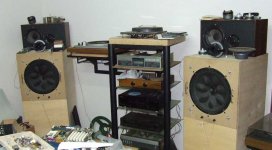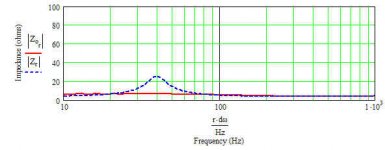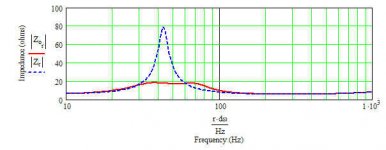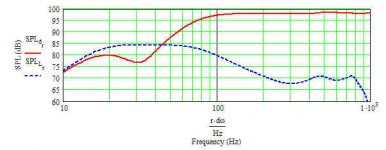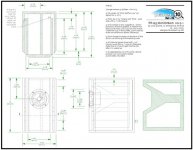Hi all. I have a question on aperiodic enclosures.
How much audible energy would you expect from the port?
I vented a system yesterday, still doing listening tests. Have done the classic boing, bonk, click test. Damping is very close to optimum with a sharp click on open circuit.
But I have deep mellow sounds radiating from the port. I thought the idea was to absorb it. So the real question is more to do with a heavily damped BR versus aperiodic.
I am very satisfied with the sound. I don't want to change it just to fit the criteria of a design.
Regards,
Geoff.
How much audible energy would you expect from the port?
I vented a system yesterday, still doing listening tests. Have done the classic boing, bonk, click test. Damping is very close to optimum with a sharp click on open circuit.
But I have deep mellow sounds radiating from the port. I thought the idea was to absorb it. So the real question is more to do with a heavily damped BR versus aperiodic.
I am very satisfied with the sound. I don't want to change it just to fit the criteria of a design.
Regards,
Geoff.
Not sure,
I have made a couple of aperiodic enclosures and I love the sound quality. On one I just used the Scan Speak aperiodic vent so I did no tuning. To me this vent looks like a 3/4 inch thick piece of fiberglass insulation smashed flat into a 1/8 - 1/4 inch thickness between two pieces of mesh.
The other one was a home made aperiodic vent. I just varied the material until I got the optimum sound. But the trick is that it needs a thin but uniform amount of resistance for the vent.
If you are stuffing a port it is easy to put too much stuffing in there and the box essentially performs like a closed box. If you have access to inside the speaker box it works best if you disgard the tuning port if there is one and glue or staple a piece of aluminum or nylon screen door material over the hole from the inside. Then you need to make a removable cover for the outside with lots of holes in it. Kind of like a speaker cover or some mesh. A tweeter cover works well for this.
Then loose stuff some polyester or cut a round piece of fiberglass insulation to go in there. The stuffing should not be very dense as it needs to breath rather well.
The outer cover of course needs to be removable so that you can vary the stuffing. If you use polyfill it is easy to put too much in there and have the vent be too resistive but it is easy to experiment with.
Also, I think it's best if the psuedo port is not tuned anywere near a low frequency because it may try to act too much like a hemholtz resonator at low frequencies. It should just be a hole in the cabinet with no tube.
The aperiodic vent is not really supposed to absorb any sound coming from the port as much as it is meant to be a variable acoustic resistance so the speaker cabinet acts kind of like a combination of infinite baffle and closed box. It's like the shock absorber on a spring more or less.
I have made a couple of aperiodic enclosures and I love the sound quality. On one I just used the Scan Speak aperiodic vent so I did no tuning. To me this vent looks like a 3/4 inch thick piece of fiberglass insulation smashed flat into a 1/8 - 1/4 inch thickness between two pieces of mesh.
The other one was a home made aperiodic vent. I just varied the material until I got the optimum sound. But the trick is that it needs a thin but uniform amount of resistance for the vent.
If you are stuffing a port it is easy to put too much stuffing in there and the box essentially performs like a closed box. If you have access to inside the speaker box it works best if you disgard the tuning port if there is one and glue or staple a piece of aluminum or nylon screen door material over the hole from the inside. Then you need to make a removable cover for the outside with lots of holes in it. Kind of like a speaker cover or some mesh. A tweeter cover works well for this.
Then loose stuff some polyester or cut a round piece of fiberglass insulation to go in there. The stuffing should not be very dense as it needs to breath rather well.
The outer cover of course needs to be removable so that you can vary the stuffing. If you use polyfill it is easy to put too much in there and have the vent be too resistive but it is easy to experiment with.
Also, I think it's best if the psuedo port is not tuned anywere near a low frequency because it may try to act too much like a hemholtz resonator at low frequencies. It should just be a hole in the cabinet with no tube.
The aperiodic vent is not really supposed to absorb any sound coming from the port as much as it is meant to be a variable acoustic resistance so the speaker cabinet acts kind of like a combination of infinite baffle and closed box. It's like the shock absorber on a spring more or less.
Hi Zen, those and Dynaco A25 and 35 etc.
These are actually my modified Wharfedales. The ones modded to use in lieu of 511s on my 811s. Even with the short 8 ohm vc they still go deep. And loud and clean. And true full range. Did my 24/7 thing last knight. Went for the volume control at 6 this morning, then the coffee.
No listening fatigue.
Cheers,
Geoff.
These are actually my modified Wharfedales. The ones modded to use in lieu of 511s on my 811s. Even with the short 8 ohm vc they still go deep. And loud and clean. And true full range. Did my 24/7 thing last knight. Went for the volume control at 6 this morning, then the coffee.
No listening fatigue.
Cheers,
Geoff.
Hi,
On this topic, does anyone have any good resources for Aperiodic enclosures?
Does the loudspeaker design cookbook have much info on Aperiodic?
I found this tid-bit:
Aperiodic Enclosure - an otherwise sealed enclosure design, but with a vent that is stuffed with damping material, which flattens out the impedance curve of the design. The area of this resistive vent should be about 10 sq. in. per cubic ft. of enclosure volume. This design might take some experimentation with the vent stuffing, testing the impedance curve several times with different amounts of damping material until the flattest impedance curve is found. The aperiodic resistive vent damps the driver in much the same way as fully stuffing a sealed enclosure with damping material (100% fill). In this way, an optimum design may be made up to 20% (or more) smaller due to the extra damping of the resistive vent. Enthusiasts of this design often compare the performance with transmission line enclosures, advocating that the design avoids the "ringing" effects of ported enclosures while alleviating the "pressure effect" of the sealed box. Dynaudio sells a DIY insertable resistive vent called the Variovent.
On this topic, does anyone have any good resources for Aperiodic enclosures?
Does the loudspeaker design cookbook have much info on Aperiodic?
I found this tid-bit:
Aperiodic Enclosure - an otherwise sealed enclosure design, but with a vent that is stuffed with damping material, which flattens out the impedance curve of the design. The area of this resistive vent should be about 10 sq. in. per cubic ft. of enclosure volume. This design might take some experimentation with the vent stuffing, testing the impedance curve several times with different amounts of damping material until the flattest impedance curve is found. The aperiodic resistive vent damps the driver in much the same way as fully stuffing a sealed enclosure with damping material (100% fill). In this way, an optimum design may be made up to 20% (or more) smaller due to the extra damping of the resistive vent. Enthusiasts of this design often compare the performance with transmission line enclosures, advocating that the design avoids the "ringing" effects of ported enclosures while alleviating the "pressure effect" of the sealed box. Dynaudio sells a DIY insertable resistive vent called the Variovent.
However,
If you look at the amount of material in a Variovent and compare it to a stuffed port you will find a big difference. Since Vance Dickison doesn't seem to have much experience with these designs. Hence the little amount of information, I chose to assume that Dynaudio had done a lot more empirical testing.
And in the end I assume that it is the level of resistance and amount of flow that matters. What really takes the cake though is instead of making an aperiodic enclosure really small is to make it as big as you can and combined with the vent it mimicks an infinite baffle or critically damped design. Fast transient response and quite neutral.
If you look at the amount of material in a Variovent and compare it to a stuffed port you will find a big difference. Since Vance Dickison doesn't seem to have much experience with these designs. Hence the little amount of information, I chose to assume that Dynaudio had done a lot more empirical testing.
And in the end I assume that it is the level of resistance and amount of flow that matters. What really takes the cake though is instead of making an aperiodic enclosure really small is to make it as big as you can and combined with the vent it mimicks an infinite baffle or critically damped design. Fast transient response and quite neutral.
Although I haven't tried it, Martin King's MathCad worksheets allow you to simulate an aperiodic vent or stuffed port. It would probably be a great starting point to get anyone "into the ballpark" when building. You'd just have to spend a little time fine tuning it in the end.
Hi GG, it seems to be a black hole. One we may have to paint!
My first encounter with aperiodic was when I was a kid. We had a pair of Wharfedales in large cabinets, about 4 or 5 cub feet. The rear panel had a series of slots almost the width of the cabinet, about 1/2" wide, and 1" apart, and lined with felt.
That's a huge cabinet compared to an A25. Your reference to port size would be in line with those cabinets.
I figured a 2" diameter port would tune my 1 cub ft cabs to 38Hz. (driver res) Rather than a 2" hole, I went to 16 1/2" holes to provide a distributed which has a wider bandwidth. The cabinet is lined with fibrefill, 30 mm at 200 GSM. The plan was to add extra material over the port, and when the correct amount obtained, place it inside.
There's a pic here: http://www.diyaudio.com/forums/showthread.php?postid=1100043#post1100043
I did find a couple of references to aperiodic. Ted Jenson designed a cabinet for the Goodmans Axiom. Called the Axiom cabinet. And it's paternted to Goodmans. Another reference points to Dynaudio, which quotes a patent, but doesn't say who owns it, using SEAS 10" drivers.
We were using aperiodic enclosures on the back of 5 and 8" Philips drivers to get rid of resonances, but never listened to what actually came out of the vent. But they produced better midrange than the sealed back units offered by Philips and Peerless at the time. (79-80)
I'll run an z sweep soon, that will tell us something.
Cheers,
Geoff.
My first encounter with aperiodic was when I was a kid. We had a pair of Wharfedales in large cabinets, about 4 or 5 cub feet. The rear panel had a series of slots almost the width of the cabinet, about 1/2" wide, and 1" apart, and lined with felt.
That's a huge cabinet compared to an A25. Your reference to port size would be in line with those cabinets.
I figured a 2" diameter port would tune my 1 cub ft cabs to 38Hz. (driver res) Rather than a 2" hole, I went to 16 1/2" holes to provide a distributed which has a wider bandwidth. The cabinet is lined with fibrefill, 30 mm at 200 GSM. The plan was to add extra material over the port, and when the correct amount obtained, place it inside.
There's a pic here: http://www.diyaudio.com/forums/showthread.php?postid=1100043#post1100043
I did find a couple of references to aperiodic. Ted Jenson designed a cabinet for the Goodmans Axiom. Called the Axiom cabinet. And it's paternted to Goodmans. Another reference points to Dynaudio, which quotes a patent, but doesn't say who owns it, using SEAS 10" drivers.
We were using aperiodic enclosures on the back of 5 and 8" Philips drivers to get rid of resonances, but never listened to what actually came out of the vent. But they produced better midrange than the sealed back units offered by Philips and Peerless at the time. (79-80)
I'll run an z sweep soon, that will tell us something.
Cheers,
Geoff.
Geoff H said:Hey Zen, if you are confused, when I said 811 I meant 411.
Too many numbers.
Geoff.
still confused
http://www.northcreekmusic.com
http://www.northcreekmusic.com/Vision/VisionCabinet.PDF
edit
on attached pic you can see pair of old ITT boxes (layin' on top of biggies) ; they're in fact OEM from Scan Speak, inside them are 21W38 and D3804 ,both Alnicos ; box have somewhere in the middle horizontally placed baffle,with rectangular hole,covered with sorta tiny felt .....this is certainly sort of inside aperiodic jobbie; x-over....naturally series one
touch of the Genius, Scaaning-who else ........(confirmed from his son
after recappin' and repairing slightly damaged cone and surround on one woof, I made sorta DIY variovent on back of each cab ; that improved further bass from cabs.
but-comparing to biggies on pic,little boxes still have too much boxiness......meaning on medium freq. range........
Attachments
Geoff H said:Hi all. I have a question on aperiodic enclosures.
How much audible energy would you expect from the port?
Greets!
Aperiodic literally means without period, so the only way I know how to do this acoustically to a point source driver is with a 'perfect' BLH, though a max flat impedance tuned TL does a pretty decent job of it, ergo in reality aperiodic normally just means either a well damped impedance peak or flattened underdamped alignment, hence the mellow sounds emanating from the vent.
GM
Attachments
Hi Zen, my numbers earlier referred to Altec Lansing.
The pic and your description matches that of the Dynaudio A35. Same SEAS drivers as the A25, but a larger cab with an aperiodic port between 2 chambers.
Greets to you GM. Thanks for the graphs. I have just done a sweep and calculations.
159 Hz 8.2 ohms
133 hz 8.2 ohms
119 hz 9.5 ohms
73 hz 8.2 ohms
25 hz 11.6 ohms
20 hz 7.9 ohms
DC 6.8 ohms.
I wonder if blocking a hole or two will flatten the peak at 25 hz. Or do I need to drill some more?
The monkey on my left shoulder says "if it aint broke, don't fix it" The one on the right says "go on do it" What I should do is pull a driver and check it's z at res. IIRC its 38hz. Wouldn't pick it in those figures.
Thanks too, for all the responses.
Geoff.
The pic and your description matches that of the Dynaudio A35. Same SEAS drivers as the A25, but a larger cab with an aperiodic port between 2 chambers.
Greets to you GM. Thanks for the graphs. I have just done a sweep and calculations.
159 Hz 8.2 ohms
133 hz 8.2 ohms
119 hz 9.5 ohms
73 hz 8.2 ohms
25 hz 11.6 ohms
20 hz 7.9 ohms
DC 6.8 ohms.
I wonder if blocking a hole or two will flatten the peak at 25 hz. Or do I need to drill some more?
The monkey on my left shoulder says "if it aint broke, don't fix it" The one on the right says "go on do it" What I should do is pull a driver and check it's z at res. IIRC its 38hz. Wouldn't pick it in those figures.
Thanks too, for all the responses.
Geoff.
Slight correction to the above figures. Thought it was too flat to be true. My PC with RTA isn't flat is it?
Corrected, the first rise is at 111 hz, at 10 ohms. the valley at 59 hz, down to 8 ohms, the lower peak at 23 hz at 20 ohms, falling to 19 ohms at 20 Hz.
There was still about 3mm of cone movement at 20, and 16.
More damping required I think.
Geoff.
Corrected, the first rise is at 111 hz, at 10 ohms. the valley at 59 hz, down to 8 ohms, the lower peak at 23 hz at 20 ohms, falling to 19 ohms at 20 Hz.
There was still about 3mm of cone movement at 20, and 16.
More damping required I think.
Geoff.
Greets!
You're welcome, though I'm surprised no one out of many dozens of 'looks' has commented on the fact that the ported plot isn't an impedance one.
After my initial reading/building/testing frenzy to try and get enough info to hopefully see alignment trends, etc., my schedule was always such that I had to use the KISS design system and once I got to where whoever needed satisfying was a Happy Camper, 'color me done'! Still, without elaborate test gear and a trained ear or three, you don't know if it's as good as it gets until you've gone past it. 'Voicing' a speaker is like racing in that until you crash you don't know the limits.
Just like with a reflex vent, more area = higher Fb until the vent's aspect ratio gets extreme, so the shape of the aperiodic vent, be it a cutout or many holes, can affect tuning, not to mention the size of the holes.
Anyway, you're right, you need more damping to knock down the lower peak and if you still can't it down enough, then increase the number of holes or vent area to allow more exposure to the damping material and try adding some more. Note that according to Small, at ~1.5 lbs/ft^3 the law of diminishing returns sets in when using fiberglass acoustic insulation, but Nouisane's tests with polyfil showed some interesting results: http://web.archive.org/web/20021007....cyberglobe.net/caraudio/resources/fiberfill/
GM
You're welcome, though I'm surprised no one out of many dozens of 'looks' has commented on the fact that the ported plot isn't an impedance one.

After my initial reading/building/testing frenzy to try and get enough info to hopefully see alignment trends, etc., my schedule was always such that I had to use the KISS design system and once I got to where whoever needed satisfying was a Happy Camper, 'color me done'! Still, without elaborate test gear and a trained ear or three, you don't know if it's as good as it gets until you've gone past it. 'Voicing' a speaker is like racing in that until you crash you don't know the limits.
Just like with a reflex vent, more area = higher Fb until the vent's aspect ratio gets extreme, so the shape of the aperiodic vent, be it a cutout or many holes, can affect tuning, not to mention the size of the holes.
Anyway, you're right, you need more damping to knock down the lower peak and if you still can't it down enough, then increase the number of holes or vent area to allow more exposure to the damping material and try adding some more. Note that according to Small, at ~1.5 lbs/ft^3 the law of diminishing returns sets in when using fiberglass acoustic insulation, but Nouisane's tests with polyfil showed some interesting results: http://web.archive.org/web/20021007....cyberglobe.net/caraudio/resources/fiberfill/
GM
Hi GM, I have been busy on the calculator, and an online port length calculator to confirm the results, remeasuring boxes, I bet you know what it's like.
Mathematically, my cabs are resonating at a tad under 85Hz. According to some data I have read, this should be a good starting point, and that explains the wide gap between the peaks. Increasing the holes to 5/8" would take it up to about 110 Hz.
So some felt is called for. What I don't want to do is loose the transparency and transient response. They still have that Altec Horn quality of pushing the voices and sax out into the room. Can't loose that.
What is surprising, with the size of the cabinets (27Litre) being tuned so high, is the amount of bass. Pretty good down to 30 Hz. Loose the fundamental below about 25.
The "ported plot" was amplitude IIRC. To me, that's more important than the z curve. No good having a flat z if it only produces heat. I have resistors for that.
Better get some work done. Customers keep ringing me.
Cheers,
Geoff.
Mathematically, my cabs are resonating at a tad under 85Hz. According to some data I have read, this should be a good starting point, and that explains the wide gap between the peaks. Increasing the holes to 5/8" would take it up to about 110 Hz.
So some felt is called for. What I don't want to do is loose the transparency and transient response. They still have that Altec Horn quality of pushing the voices and sax out into the room. Can't loose that.
What is surprising, with the size of the cabinets (27Litre) being tuned so high, is the amount of bass. Pretty good down to 30 Hz. Loose the fundamental below about 25.
The "ported plot" was amplitude IIRC. To me, that's more important than the z curve. No good having a flat z if it only produces heat. I have resistors for that.
Better get some work done. Customers keep ringing me.
Cheers,
Geoff.
I stuffed the holes with fibre fill today. Quick-n-dirty way of adding damping.
The results:
135 Hz. z starts to rise
95 Hz - 12r
85 Hz - 12r4 ??
67 Hz - 17r where it peaks
40 Hz - 10r (that's good)
30 Hz - 9r5 (so's that)
21 Hz - 9r6.
The peak at 67 is where you would expect from the driver in such a
tight enclosure. No lumpiness, but I want to see if I can flatten that peak.
No ill effects up top. Yeah. Its all good. Apart from a rattle somewhere to the right at 21. Bookshelf!
Geoff.
The results:
135 Hz. z starts to rise
95 Hz - 12r
85 Hz - 12r4 ??
67 Hz - 17r where it peaks
40 Hz - 10r (that's good)
30 Hz - 9r5 (so's that)
21 Hz - 9r6.
The peak at 67 is where you would expect from the driver in such a
tight enclosure. No lumpiness, but I want to see if I can flatten that peak.
No ill effects up top. Yeah. Its all good. Apart from a rattle somewhere to the right at 21. Bookshelf!
Geoff.
Hi guys, just a quick question.
As my first speaker project I have built a pair of FR125s Mini-Onken's.
I have stuffed some light foam just inside the internal opening of the vents indicated in the diagram.
I am very happy with the sound per £/$ performance. Lovely detailed bass from tiny drivers.
Does this mean that they are now Aperiodic chaps?
Lee.
As my first speaker project I have built a pair of FR125s Mini-Onken's.
I have stuffed some light foam just inside the internal opening of the vents indicated in the diagram.
I am very happy with the sound per £/$ performance. Lovely detailed bass from tiny drivers.
Does this mean that they are now Aperiodic chaps?
Lee.
- Status
- This old topic is closed. If you want to reopen this topic, contact a moderator using the "Report Post" button.
- Home
- Loudspeakers
- Multi-Way
- Aperiodic enclosures
